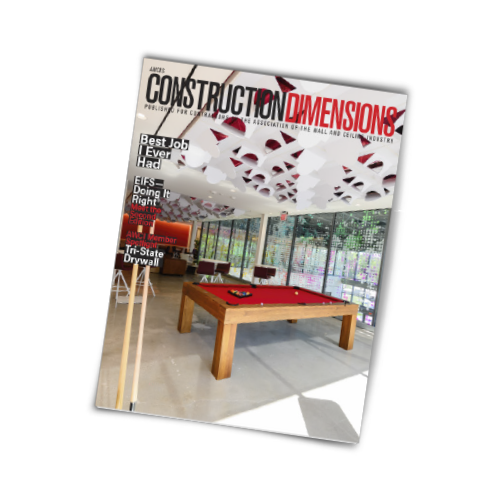Shawn Burnum takes the helm as president of the Association of the Wall and Ceiling Industry this July as the pandemic fades and the industry rights itself. Not for a moment, however, does he think things will go exactly back to how things were before the pandemic. Nor should they.
There are things to learn from the tough months gone by on how to conduct business differently moving forward, says the 49-year-old vice president of operations at Performance Contracting, Inc., the largest wall and ceiling contractor in the United States. And Burnum relishes the challenge. “This is going to be a fun year for me. I’m ready to roll,” he says.
Back to In-Person Meetings
Burnum sees “a good energy” in the association and expects many of his colleagues will be enthusiastic about “being back in the room again” as more association meetings shift from virtual to in-person settings. “I think there is a sense of excitement for everyone in re-engaging,” he says.
The association’s members will have an opportunity to meet again in New Orleans when AWCI holds its 2021 annual convention in October. AWCI will be kept on its toes as it turns around to host its 2022 convention six months later in April in Grapevine, Texas, near Dallas–Fort Worth. Having the two conventions so close together will be an organizational challenge, but Burnum sees it as an important step for AWCI.
Another pivotal meeting comes this month (July) when AWCI holds an in-person strategic planning session with association thought leaders to work on collective goals. The incoming president has high hopes on its outcome. Along with association staff and leaders including AWCI CEO Michael Stark, the meeting will have a cross-section of contractors, manufacturers and suppliers from across the United States. “As we have all been through a lot the past few years,” says Burnum, “the idea here is to lift the hood, hit the pause button and maybe even re-program what we want to do, look at our objectives.”
Burnum, who has a master’s degree in organizational management, hopes the two-day event—led by a professional facilitator “to really challenge us”—will culminate in a plan “everybody can coalesce around” for the next few years. He has been working closely on several issues with incoming vice president Travis Vap (South Valley Drywall, Inc. in Colorado) that they hope will add value to the association for years to come. “It shouldn’t just be the president’s plan because we otherwise boomerang the AWCI staff from one idea to the next every year when we switch out people in my position,” he explains.
One of the topics the two executives will raise is how to engage new, young leaders—an issue that is coming to the forefront as some active members near retirement. “If you look at who participates in AWCI, the vast majority are on the latter part of their careers,” Burnum says. “Tapping into the next generation, making sure they and their employees are engaged and passionate about the association is a challenge. Collectively, we have not reached that stage yet.”
Calling himself “a broad thinker” with a bent for leadership, Burnum says he hopes the strategic planning session establishes markers for a three- to five-year blueprint for the association. “What that will do is give us the momentum to get things done,” he says. “On a year-to-year cycle you just can’t get enough done fast enough.”
Guidance for Upcoming Leaders
Burnum, who suggests that the growing crop of new executives leading today’s contracting companies might need a hand as they take the reins in an ever-complex business, thinks a focused emerging leaders program at AWCI might be worth implementing. The idea, he says, is to offer participants advice on the technical skills of running a business. Issues such as bonding and insurance requirements, financing and manufacturer relationships would be covered, and content could include soft skills such as interpersonal, time management, communication and listening skills.
The program’s framework could see manufacturers hosting educational events and member-contractors inviting out-of-town contractors to tour its facilities, or walk a job site where they can witness best practices—from tracking costs to keeping workers safe and healthy.
Burnum explains: “What I’m thinking is having leader-to-leader accountability and collaboration here. We need the next generation of leaders to get excited to participate, to have a reason to write a check, have a reason to get on a plane with their employees and come be a part of our association’s events.”
He says decades ago many members were drawn to big AWCI events like conventions primarily to rekindle old friendships, network and attend educational sessions. Those reasons might not be enough to draw today’s young members who are apt to look to social media for connections and the internet for technical information. “We are disconnected … we have to find other reasons to show up in the room,” he says.
While the membership continues to be engaged in AWCI, Burnum doesn’t want to see it fall into the same trap that other construction industry associations have experienced: a lost focus on what steps to take to grow in changing times. Just keeping up membership numbers isn’t enough to stay relevant. Finding members who will help move the association forward has to be a priority.
“I want to make sure we are doing everything we can to add value to all participants (members),” Burnum says, “but primarily I think that comes by adding value for the contractors.”
Influential Unknown Factors
The pandemic’s impact on the association is still unknown, but the convention this fall could tell how times are shaping up, partly based on who shows up, he suggests. Besides the usual stalwarts who attend annually, Burnum wonders whether any of “the 10-15%” of its membership that normally sit on the fence will attend. Capturing that segment might be seminal in the future as the AWCI continues its efforts to be an industry-leading resource and information source.
While the industry struggles with the effects of the lengthy lockdowns and hard times since early last year, Burnum points to areas where the industry has improved because of COVID-19. The use of social media is a case in point, and platforms such as Zoom have built a large following as avenues to share information and resolve problems. Such platforms should open doors, long after the pandemic has passed, to technical and educational forums for members and their employees who might have been excluded from events in the past.
“Now, our entire office can participate. For example, a payroll administrator who would have never come to a convention, can attend a virtual presentation on something related to hiring,” Burnum suggests.
Among the hurdles many contractors will face as the economy picks up speed this summer are lingering material shortages and sky-high prices. Steel and mineral fiber insulation continue to be scarce, and drywall finishing compounds are in short supply.
A concerning possible trend, however, is that owners might push the pause button on projects until the prices of materials—lumber, for example—fall. While consumer demand remains high, supply is in a catch-up mode, particularly with some manufacturers “still wrestling with COVID-19” and hitting full production again. “I think the demand will cool as we stimulate the economy,” Burnum says.
It is too early to say what impact the Biden administration’s proposed infrastructure initiative could have on the wall and ceiling industry, he says, but the federal bill includes new schools, work at airports and federal institutions that could benefit AWCI members.
About PCI
Performance Contracting has offices coast to coast, and it is headquartered in Kansas City—a strategic choice by its leaders to be in the middle of the country. As vice president, Burnum is responsible for PCI offices in states from Iowa to Texas, from New England south to Washington, D.C., and Maryland in the east. In pre-pandemic times he was on an airplane most weeks to visit various branches.
While PCI closed its offices during the pandemic, it continued to work remotely and conducted operations on construction sites. “We didn’t have to close our business,” he says, but workforce numbers were slashed in some regions. In Seattle, for example, a field crew of 300 was pared to 30 during the worst times of the pandemic.
PCI has been a leader on job sites throughout the pandemic, even going to lengths to train competitors in health and safety procedures to ensure construction-site safety. “We put a lot of effort into the pride of being essential,” Burnum explains. “I said, ‘View COVID as nothing different from an everyday event where we’re having to adapt as a team to do something different and react to a problem that nobody could perceive. Frankly, our industry is really good at that.”
Moving ahead, he hopes that health and safety standards introduced by general contractors, project managers and others will remain after the pandemic. Burnum says, “We have got to get out of the mindset as an industry of treating our partners in the field differently than we would want to be treated in the office.”
Burnum maintains that better site sanitation conditions can be an effective means of attracting more young people to the field. He points to a case where one of PCI’s clients on a remote, muddy job site met with the trade companies to discuss how to improve working conditions to retain workers and attract more. “They ended up paving walkways, improving sanitary conditions and putting picnic tables outside the job site for breaks,” he says. “It was astounding how much better and easier it was to attract people to that job site.”
Kansas City, Mo., has been Burnum’s home base for almost 15 years. He is proud of the city’s record managing the pandemic, calling its managers “responsible and responsive” to outbreaks without “hitting the panic button.”
Burnum came to Performance Contracting as a project executive on a $20 million–plus job in Washington, D.C. After the job was completed, he took the post of general manager for the firm in the Kansas City office, and about three years ago became vice president of operations.
What works for him on the job? “I get a lot of reward out of building my teams,” he says. “I love to watch people grow and win and succeed, take on more and stretch. Over the next five-plus years, if I can help continue to build that nucleus of folks in the industry as well as my company, I’m going to be very happy.”
When Off the Job
In his spare time, Burnum is never bored. A car enthusiast, he owns a 2008 Corvette and a 1956 Ford F-100 pickup, both of which run well but can always do with a little fixing or restoring. Also an avid woodworker, he has a workshop where he restores antiques and builds new projects such as cabinets. “My house is full of really awesome antiques,” he says. “They are not worth a lot (in this market), but to me they are.”
Burnum has been married to Misty for 27 years and has a son, Trent, who recently graduated from college, and a daughter, Tristan, who just got a summer internship and will be entering her junior year in college this fall. He is excited about both his children’s recent academic successes.
Raised in Southwest Missouri, Burnum attended Pittsburg State University and was accepted to law school with plans to become a construction attorney. Instead, fate stepped in, and now he says he has no regrets about the change in his career path.
AWCI has no regrets about his decisions either. All have great expectations for his tenure as AWCI’s president.
Don Procter is a freelance writer in Ontario, Canada.





